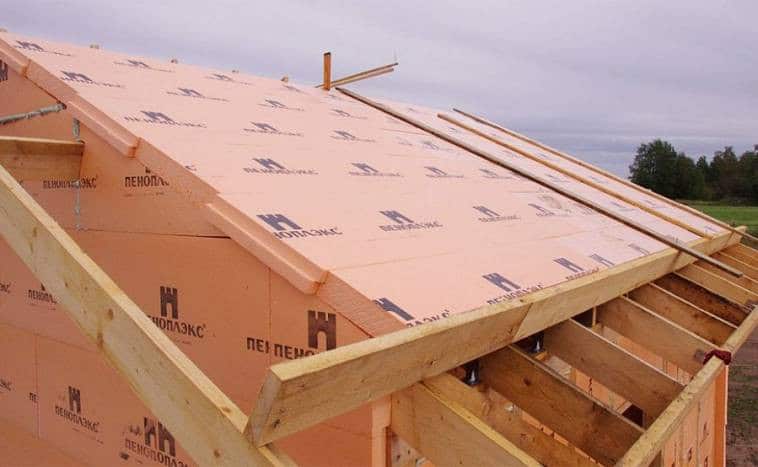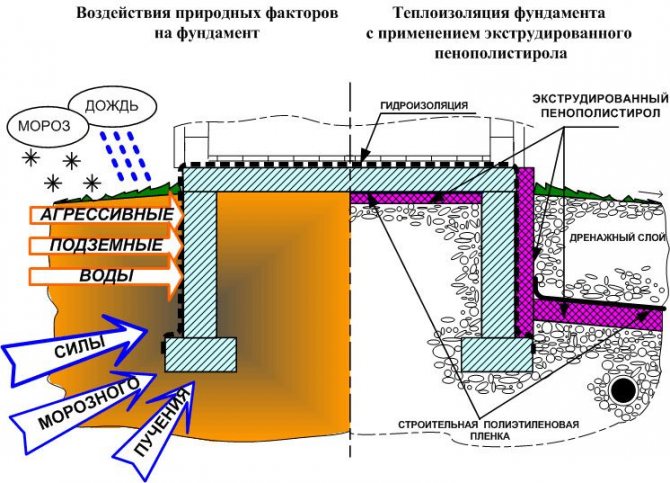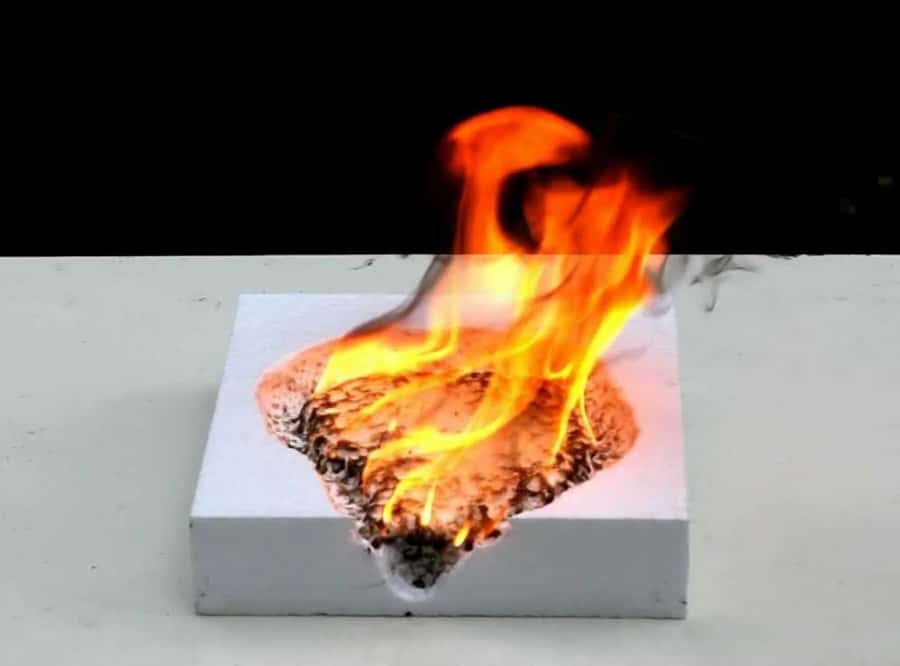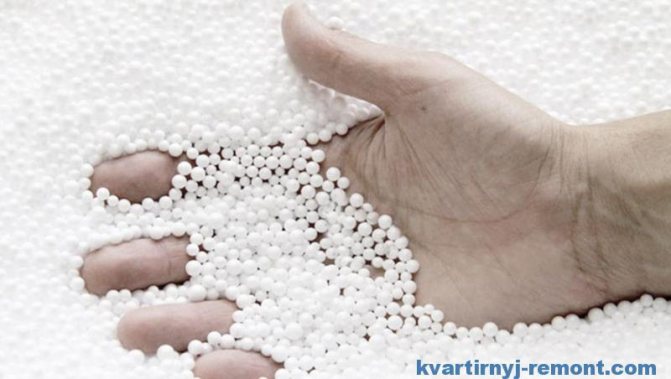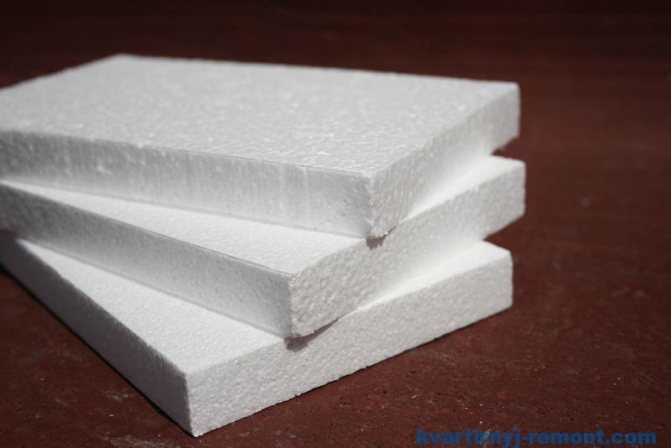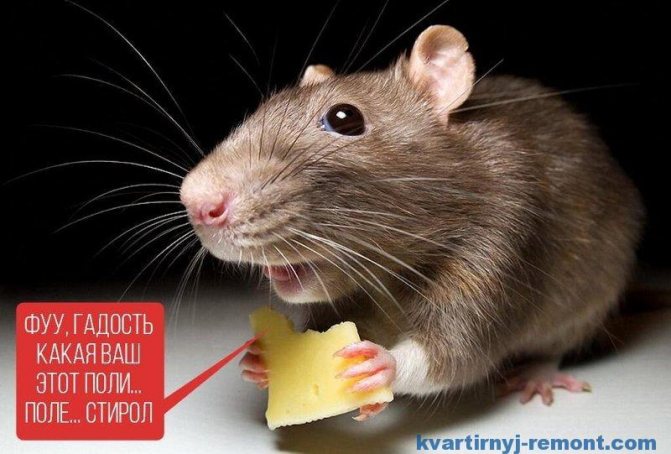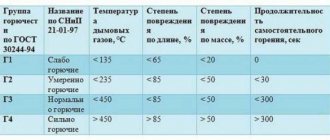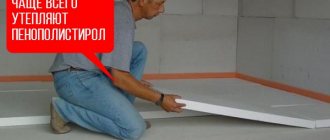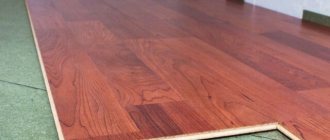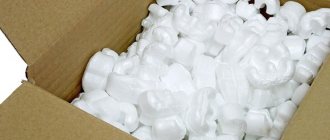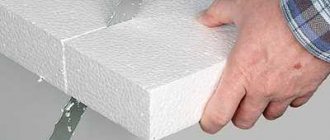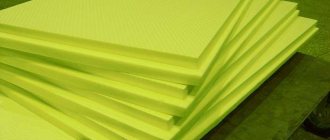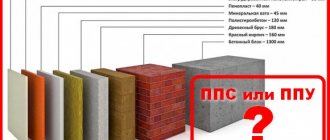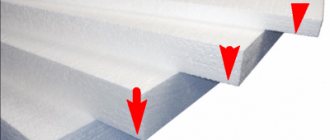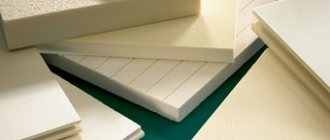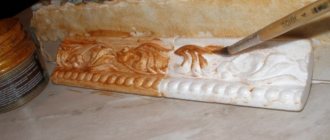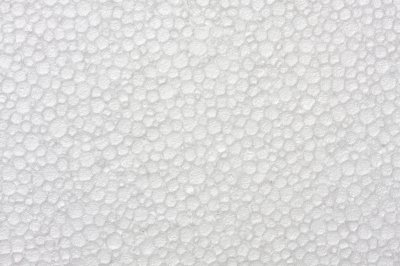
Expanded polystyrene Suspension Pressless Self-extinguishing (PSB-S) on a cut (EPS)
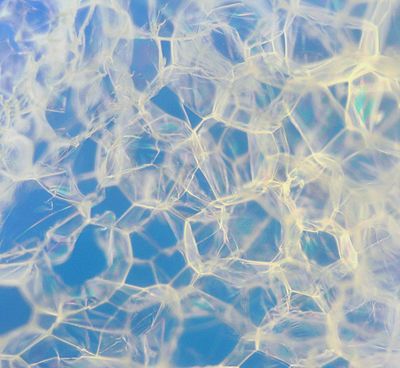

The structure of expanded polystyrene at high magnification
Pénopolistirole
is a gas-filled material obtained from polystyrene and its derivatives, as well as from styrene copolymers. Expanded polystyrene is a widespread type of polystyrene, which is usually called in everyday life. The usual technology for producing expanded polystyrene is associated with the initial filling of styrene granules with gas, which is dissolved in the polymer mass. Subsequently, the mass is heated with steam. In the process of this, a multiple increase in volume of the original granules occurs until they occupy the entire block shape and are not sintered together. In traditional expanded polystyrene, natural gas, which is readily soluble in styrene, is used to fill the granules; in fire-resistant versions of expanded polystyrene, the granules are filled with carbon dioxide [1]. There is also a technology for obtaining vacuum expanded polystyrene, which does not contain any of the gases.
Content
- 1 History of the production of expanded polystyrene
- 2 Composition of expanded polystyrene
- 3 Methods of obtaining
- 4 Properties of expanded polystyrene
- 5 The main types of produced polystyrene foam
- 6 Application
- 7 Properties of expanded polystyrene 7.1 Water absorption
- 7.2 Vapor permeability
- 7.3 Biological stability
- 7.4 Durability
- 7.5 Resistance to solvents
- 8.1 High temperature degradation
- 9.1 Fire hazard of untreated polystyrene foam
The history of the production of expanded polystyrene
The first expanded polystyrene was produced in France in 1928 [2]. Industrial production of expanded polystyrene began in the 1937s. [specify
] in Germany [3]. In the USSR, the production of expanded polystyrene (grade PS-1) was mastered in 1939 [4], grades PS-2 and PS-4 - in 1946 [5], grade PSB - in 1958 [6] In 1961, the USSR mastered the technology for the production of self-extinguishing expanded polystyrene (PSB-S) [7]. For construction purposes, PSB expanded polystyrene began to be produced in 1959 at the Stroyplastmass plant in Mytishchi.
Composition of expanded polystyrene
To obtain expanded polystyrene, polystyrene is most often used. Other raw materials are polymonochlorostyrene, polydichlorostyrene, and copolymers of styrene with other monomers: acrylonitrile and butadiene. Low-boiling hydrocarbons (pentane, isopentane, petroleum ether, dichloromethane) or blowing agents (diaminobenzene, ammonium nitrate, azobisisobutyronitrile) are used as blowing agents. In addition, the composition of expanded polystyrene boards includes fire retardants (flammability class G1), dyes, plasticizers and various fillers.
Foil polystyrene foam
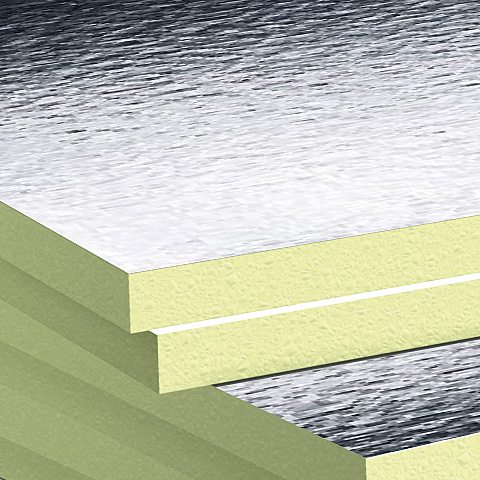

It is a mixed heat-insulating material, which is covered on two or one side with polished foil with an aluminum interlayer or metallized polypropylene film. Due to the metallic properties of the coating, the reflection effect can be as high as 97%. The choice of FPS as a solution for underfloor heating is considered the ideal insulation. The foil layer reflects heat rays, thereby improving the performance of the insulating properties of the material. FPS is also used to insulate pipes for heating networks; thermal insulation of ventilation ducts, air ducts in ventilation and air conditioning systems; thermal insulation of walls; sound insulation between floors; used as technical insulation of technological equipment.
Methods of obtaining
A significant proportion of the obtained polystyrene foam is produced by foaming the material with vapors of low-boiling liquids. For this, a suspension polymerization process is used in the presence of a liquid that can dissolve in the original styrene and is insoluble in polystyrene, for example, pentane, isopentane, and their mixtures. In this case, granules are formed, in which the low-boiling liquid is evenly distributed in the polystyrene. Further, these granules are subjected to heating with steam, water or air, as a result of which they significantly increase in size - 10-30 times. The resulting bulk granules are sintered with simultaneous molding of products.
What material should you prefer - ordinary PS or is it EPS?
In this case, you need to consider all the pros and cons of both materials, as well as the amount of the budget allocated for the production of work on thermal insulation. In this regard, EPS is about 1.2-1.5 times more expensive than ordinary polystyrene, so the latter in private construction (when you have to take into account literally every penny) does not give up its positions for so long.
So, let's make a visual comparison of materials according to the main characteristics:
- Thermal conductivity - the less it is, the more effective the insulation is. In this regard, the ERS index is 0.028 W / mK, and the usual PS is 0.039 W / mK. Thus, the EPS turns out to be more effective.
- Mechanical strength. Here the EPS also comes out on top, since its structure is monolithic. The bending strength of the EPS is 0.4 - 1 MPa, and the compressive strength 0.25 - 0.5 MPa. For ordinary foam, these characteristics are, respectively, 0.07 -0.2 MPa and 0.05 - 0.3 MPa.
- Water absorption - the ability to absorb water. In a good insulation, it should tend to zero, otherwise the thermal conductivity increases sharply. EPS, which has closed cells, has almost zero water absorption, which is no more than 0.4% when the material is immersed in water for 30 days. A conventional PS absorbs up to 4% of water over the same period of time. Therefore, in cases where it is supposed to operate the structure in difficult conditions from the point of view of humidity, it is better to use extruded material.
- Fire resistance - especially important when you need to insulate a building built of combustible materials or a production facility. In this regard, there is no particular difference between EPS and PS, they refer to combustible materials of the G3-G4 flammability group. Although they contain flame retardants, this does not guarantee their safety during a fire. In addition, when heated, they begin to emit toxic gas.
- Shrinkage is the scourge of many heaters. During operation, many of them decrease in size, sag, and gaps are formed, which subsequently serve as cold bridges. Styrofoam can also shrink significantly when heated. Therefore, it is better not to use it in underfloor heating systems, and when insulating facades, it is necessary to isolate insulation plates from UV radiation and heating with a layer of light plaster in a short time. The EPS in this plan behaves much better - it practically does not shrink.
Thus, knowing the purpose of the material and the place of its installation, in each individual case, you can make the most appropriate choice both in terms of the properties of the insulation and in terms of its cost.
Properties of expanded polystyrene
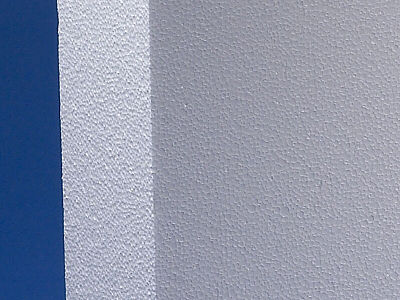

High quality expanded polystyrene: material with evenly spaced granules of the same size
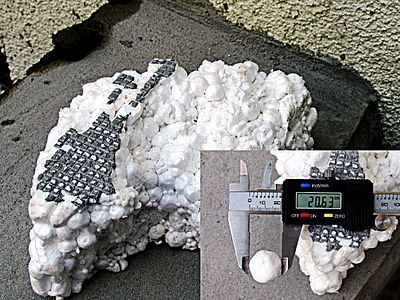

Low-quality expanded polystyrene of the PSB type: a break occurs along the contact zone of balls of different sizes
Expanded polystyrene, which was obtained by foaming a low-boiling liquid, is a material consisting of fine-cellular granules sintered together. There are micropores inside the expanded polystyrene granules, and voids between the granules. The mechanical properties of a material are determined by its apparent density: the higher it is, the greater the strength and the lower the water absorption, hygroscopicity, vapor and air permeability.
Features of the production of extruded polystyrene foam
Production is regulated by GOST 32310-2012.The manufacturing process of this thermal insulation material takes place in an extruder. The feedstock - polystyrene granules - enters the reactor, where it is saturated with gas at high temperatures and pressure. After reducing the pressure, the resulting mass expands rapidly. The foam enters a calibrating device - a flat die. The resulting polymer material has a homogeneous structure with closed cells in which air is enclosed. PPE can be white or colored. Density - 28-45 kg / m3.
The main types of produced polystyrene foam
- Pressless expanded polystyrene
: EPS (Expanded Polystyrene); PSB (Suspension non-pressed expanded polystyrene foam); PSB-S (Expanded polystyrene suspension, pressless, self-extinguishing). Invented by BASF in 1951 - Extruded polystyrene foam
: XPS (Extruded Polystyrene); Extrol, Penoplex, Styrex, Technoplex, TechnoNIKOL, URSA XPS - Extruded polystyrene foam
: various foreign brands; PS-1; PS-4 - Autoclave polystyrene foam
: Styrofoam (Dow Chemical) - Autoclave-extruded polystyrene foam
[8]
Application
Expanded polystyrene is most often used as a heat-insulating and structural material. Scopes of its application: construction, carriage and shipbuilding, aircraft construction. Quite a large amount of expanded polystyrene is used as a packaging and electrical insulating material.
- In the military industry - as a heater; in the systems of individual protection of military personnel; like a shock absorber in helmets.
- In the production of household refrigerators as a heat insulator (in the USSR, these are serially produced refrigerators "Yarna-3", "Yarna-4", "Vizma", "Smolensk" and "Aragats-71") until the early 1960s, when expanded polystyrene was displaced by polyurethane foam.
- In the production of containers and disposable isothermal packaging for frozen products [9] [10] [11] [12]
- In the construction of buildings - the use of expanded polystyrene in Russia in the construction industry is regulated by state standards [13] [14] [15] and is limited to the use of a building envelope as a middle layer. Expanded polystyrene is widely used for insulating facades (flammability class G1). The potentially high fire hazard of this material requires mandatory preliminary full-scale tests [16]. In August 2014, the FGBU VNIIPO EMERCOM of Russia noted [17] that the use of SFTK ("Systems of facade heat-insulating composite") as a heater (thermal insulation) of the main plane of the facade of tiled polystyrene foam (only those brands that are indicated in the TS), which is not material for finishing or facing the outer surfaces of the outer walls of buildings and structures, contrary to the requirements of Article 87, part 11 of the Federal Law No. 123-FZ [18] and paragraph 5.2.3 of SP 2.13130.2012. In July 2020, the modern GOST 15588-2014 “Foamed polystyrene heat-insulating plates. Technical conditions ", indicating the mandatory presence of fire retardant additives in the material, ensuring fire safety (self-extinguishing, inability to maintain independent combustion) of expanded polystyrene plates during storage and installation.
- Since the 1970s. expanded polystyrene is used in the construction of roads, the construction of artificial reliefs and embankments, the laying of transport routes in areas with weak soils, when protecting roads from freezing, to reduce the vertical load on the structure, and in a number of other cases. Expanded polystyrene is most actively used in road construction in the USA, Japan, Finland and Norway [19]. The requirements and standards of GOST for this product in these countries are radically different from the Russian and CIS countries.
- Serves as a material for the production of toys, designer furniture and interior items [20]. It also serves as a material for creating objects of modern decorative and applied art and conceptual art [21].
Heaters
109 votes
+
Voice for!
—
Against!
Expanded polystyrene is a rather interesting material.The production method was patented back in 1928, and has been modernized many times since then. The main advantage is low thermal conductivity, and only then in light weight. Expanded polystyrene is widely used in various industries and construction, and each person, in one way or another, came across products from it in everyday life. In addition, expanded polystyrene, the price of products from which is at a low level, will be a good option if you want to insulate your home.
Table of contents
- What is expanded polystyrene and how is it different from polystyrene?
- Expanded polystyrene, characteristics and properties
- Application area
- Disadvantages of expanded polystyrene: an overview of the myths
What is expanded polystyrene and how is it different from polystyrene?
Expanded polystyrene is produced by adding gas to the polystyrene polymer mass, which, upon subsequent heating, significantly increases in volume, filling the entire mold. Depending on the type of material, a different gas is used to create volume: for simple variations, natural gas, fire-resistant types of expanded polystyrene are filled with carbon dioxide.
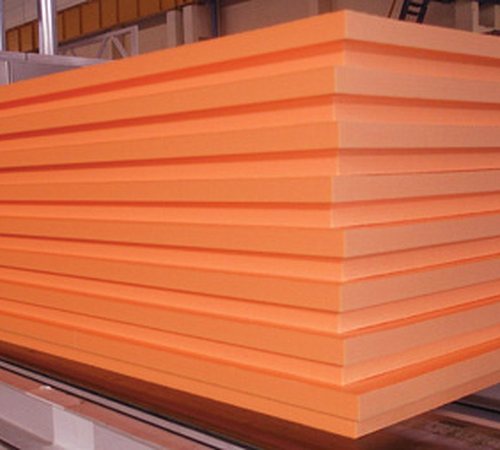

Quite often, amateurs tend to call polystyrene foam and polystyrene the same material. However, this is not entirely true. They have a common basis, but the differences and characteristics are quite significant. If you do not go into long spatial reasoning, then the main distinguishing features are as follows:
- the density of the foam is significantly lower, 10 kg per m3, while the indicators of polystyrene foam are 40 kg per m3,
- expanded polystyrene does not absorb steam and moisture,
- the appearance is different. Polyfoam - has internal granules, polystyrene foam is more homogeneous,
- foam plastic is characterized by a lower cost, which is noticeable when it is used as a heat-insulating material for the outer cladding of the walls of a building,
- expanded polystyrene has the best mechanical strength.
Polyfoam is produced from polymer raw materials, which are treated with steam, as a result of which the volume of the granules increases significantly. But at the same time, this leads to the fact that the micropores also increase in size, as a result of which the bond between the granules deteriorates and gradually, under the influence of atmospheric precipitation and climatic conditions, this leads to the fact that the material weakens. Roughly speaking, if you break a sheet of polystyrene in half, a large number of granules are formed. This is not typical of expanded polystyrene, since initially it consists of closed cells, which ensure the moisture and vapor impermeability of the material. At the beginning of production, its granules under the influence of high temperatures melt, forming a uniform fluid mass, which is filled with gas.
The material itself also has several varieties:
- Extruded polystyrene foam is practically the same material as non-pressed, the difference is in the use of equipment such as an extruder, therefore, extruded and extruded polystyrene foam is often called the same material.
- Extrusion is also obtained by processing the final mass of polymer material, and is also a homogeneous mass. The variety is used for the manufacture of disposable packaging and tableware. Roughly speaking, meat products in supermarkets are packed in packaging made of extruded polystyrene foam.
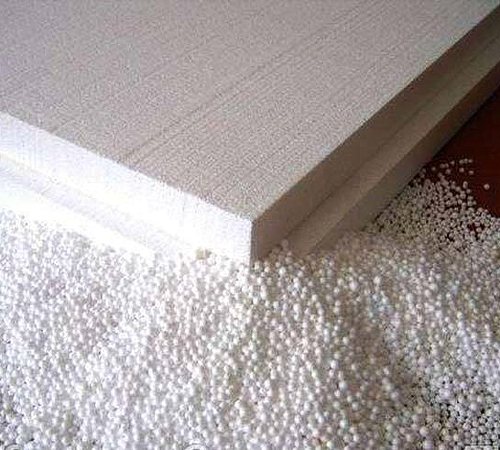

- The press method of obtaining the material is more expensive, since it involves the subsequent pressing of the gas-foamed mixture. In this case, it acquires additional strength.
- Autoclave polystyrene foam is rarely mentioned, and in fact, it is an extrusion type in which the foaming and baking of the material is performed using an autoclave.
- Pressless is one of the most popular varieties. Moisture is first removed from polystrirole granules by drying, then foamed at 80 ° C, then dried again and then heated again. The resulting mixture is filled into a mold, where it is already self-compacting at the time of cooling.This type of expanded polystyrene is more fragile, but requires half as much isopetane for its production, which affects the final cost.
Expanded polystyrene, characteristics and properties
Expanded polystyrene is an ambiguous material: someone exalts its properties to the skies, someone, on the contrary, foaming at the mouth, demands an immediate and complete ban on its use on the basis of "exposing the works of one academician." True, the ubiquity of expanded polystyrene and its high popularity incline conclusions towards the fact that this material is really good and has the following advantages:
- Low thermal conductivity allows a significant insulation effect to be achieved. In fact, 11 cm of expanded polystyrene can provide the same thermal insulation as a silicate brick wall more than two meters thick. The thermal conductivity of the material is 0.027 W / mK, which is significantly lower than that of concrete or brick,
- Moisture resistance of the material. Even with prolonged exposure to moisture, the absorbency will be no more than 6%, so there is no need to fear deformation of the structure of expanded polystyrene.
- Expanded polystyrene is durable and can withstand up to 60 cycles of exposure to temperatures from -40 to + 40 ° C. Each cycle constitutes an estimated climatic year.
- Insensitivity to the formation of biological media. Expanded polystyrene will not become a breeding ground for fungi and mold.
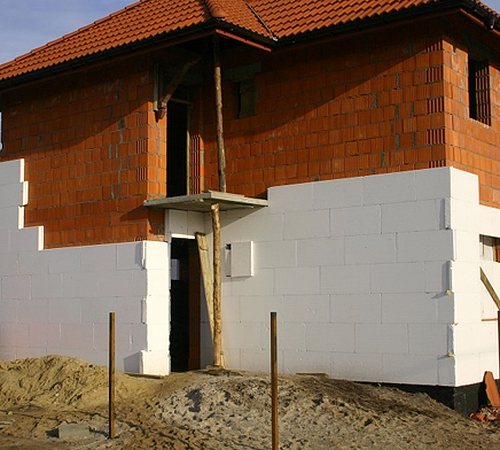

- Harmlessness of the material. In its production, non-toxic components are used, therefore, products from expanded polystyrene are also used in the food industry. For example, for storing food.
- Due to its light weight, insulation of building facades with expanded polystyrene takes much less time and effort than when using other means.
- Fire-resistant grades of material, when exposed to an open flame, tend to self-extinguish and melt, not spreading combustion. The spontaneous combustion temperature of expanded polystyrene is + 490 ° C, which is almost two times higher than that of wood. If the material is not exposed to an open source of flame for more than four seconds, the expanded polystyrene extinguishes. The heat energy during combustion of the material is 7 times less than that of a tree. Therefore, expanded polystyrene is not able to support the fire site.
- Providing soundproofing. This quality is especially important for residents of standard apartments. A 3 cm layer of insulating material is sufficient to reduce noise penetration by 25 dB.
- The vapor permeability of the material is at a low level of 0.05 Mg / m * h * Pa, regardless of the degree of foaming and the density of the grade. In fact, the vapor permeability indicators are similar to the timber frame of pine or oak.
- Resistant to alcohols and ethers, but easily subject to destruction when solvents come into contact with the surface of the material.
- The tensile strength is at least 20 MPa.
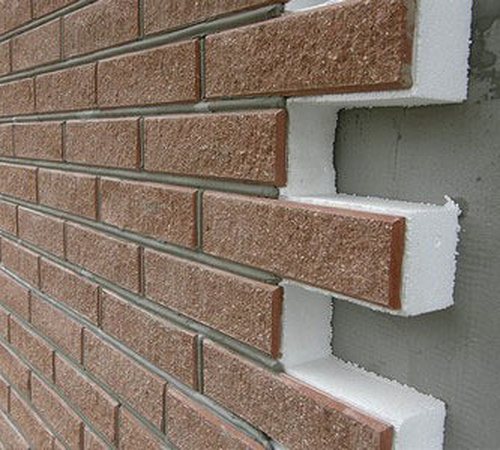

As can be seen from the above, expanded polystyrene is an effective tool for solving many problems: from using some of its varieties as packaging to providing heat and waterproofing of building facades. In addition, the material is used for other purposes in construction, which will be discussed below.
Application area
Expanded polystyrene in construction is used primarily for insulating the following elements:
- water pipes,
- roofs,
- floors,
- door and window slopes,
- walls.
For example, the consumption of expanded polystyrene for pipe insulation is economically justified and reasonable due to its capabilities. Moreover, for these purposes, molded block polystyrene foam is used, which allows, in the event of a pipe damage, to easily access it by removing the desired section of the protective coating.
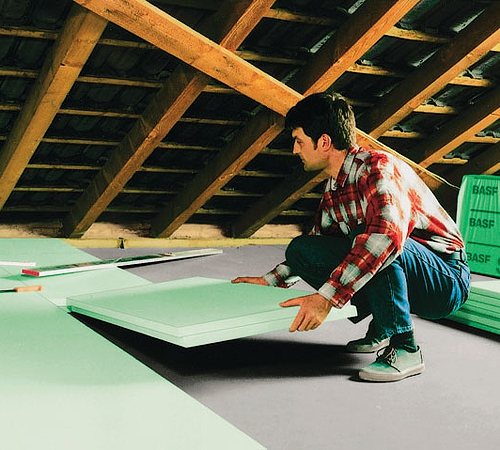

Expanded polystyrene is actively used in the construction of transport routes. It reduces the effect of vertical loading on the floor during construction of buildings. Widespread in the production of SIP panels.
The scope of application of expanded polystyrene, the characteristics of which, combined with a low price, make it extremely attractive for use in any industry, is practically unlimited. The only thing that should be taken into account is that the material has a low density, therefore, it is susceptible to any mechanical damage.
Disadvantages of expanded polystyrene: an overview of the myths
In addition to the bouquet of advantages, there are also disadvantages. Moreover, a large number of various myths are associated with expanded polystyrene, which must be considered in more detail:
- Many manufacturers claim that extruded expanded polystyrene foam is significantly superior to other varieties, as evidence of which they often expose a table of comparative characteristics of this variety in comparison with ordinary foam. Nevertheless, the difference in thermal conductivity between extruded and extruded polystyrene foam is practically not noticeable and amounts to 0.002 units, at the same time, due to advertising, the cost of extrusion plates for insulation is higher.
- The maximum density of expanded polystyrene gives the same high performance when insulated. According to experts, such a statement has some discrepancies with reality, since the more closely the molecules adhere to each other, the higher the thermal conductivity becomes and it is easier for cold to penetrate the room. A way out of this situation will be the use of low-density expanded polystyrene plates, which must be covered with a reinforcing mesh and a protective layer of primer in order to increase their mechanical strength.
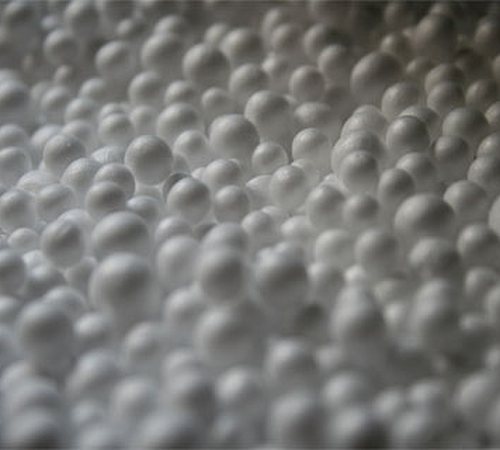

- Fire-resistant polystyrene foam is absolutely non-flammable and harmless to the human body. Any building material, when exposed to an open flame, will exhibit combustion properties, more or less. However, the spontaneous combustion temperature of expanded polystyrene is higher than that of wood, and in addition, it emits significantly less thermal energy during combustion. It is important to remember that fire-resistant varieties, despite the loud name, are by no means able to stop the flame, only to reduce its effect. Carbon dioxide, which is used in its production, will become a serious disadvantage of a fire-resistant variety compared to the usual one. As a result, when reflowing, the material will begin to emit a significantly large amount of harmful substances. Some sellers talk about incombustibility on the basis of demonstrative experience: when the base with a plate of insulation fixed on it begins to warm up from the back side. When exposed to high temperatures, polystyrene foam begins to melt and deform, while there is no fire. However, as long as the flame is exposed to it, the material will continue to burn.
- Fire retardants added to polystyrene foam for its fire resistance are "in any case, pure poison." Another controversial statement. A fire retardant is a component containing substances in its structure that slow down the combustion process. They differ in composition and contain various components, ranging from formaldehydes, which are really dangerous for humans, to magnesium salts, which are quite environmentally friendly and safe. Recently, solutions based on inorganic salts have been increasingly used, so they are not capable of harming health. Fire retardants are often used to impregnate and apply a protective layer to wood to increase its fire resistance.
- Installation of polystyrene foam insulation materials is not able to provide heat. In fact, the task of the insulation is not to bring heat, but to keep it indoors. Roughly speaking, the use of insulating plates will significantly reduce the escape of heat outside the premises, thus, you will not have to heat the street at your own expense.
- "Expanded polystyrene is hazardous to health." Modern production allows you to create material from environmentally friendly components, so there is no threat to health. Moreover, the widespread use of products for storing semi-finished products and use in everyday life speaks, just about the safety of the material.
More often, problems arise when you want to buy expanded polystyrene of cheaper and lower quality varieties.Insulation boards made of such a material really have less strength and are able to begin to deform even at temperatures above 40 ° C. The main rule when using materials from expanded polystyrene in any industry will be to ensure quality and reliability, for which you have to pay. And then in the course of operation, only dignity will appear.
Properties of expanded polystyrene
Water absorption
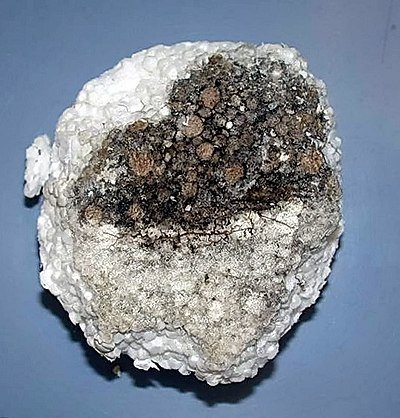

Colony of bacteria on EPS
Expanded polystyrene is capable of absorbing water in direct contact [22]. The penetration of water directly into the plastic is less than 0.25 mm per year [23], therefore, the water absorption of polystyrene foam depends on its structural features, density, manufacturing technology and the duration of the period of water saturation. The water absorption of extruded polystyrene foam even after 10 days in water does not exceed 0.4% (by volume), which makes it widely used as a heater for underground and buried structures (roads, foundations) [24].
Vapor permeability
Expanded polystyrene is a low vapor permeable material [25] [26].
A feature of the vapor permeability of expanded polystyrene is that it does not depend on its degree of foaming and the density of expanded polystyrene and is always equal to 0.05 mg / (m * h * Pa) [source unspecified 1930 days
], which is not equivalent to the vapor permeability of a wooden frame made of pine, spruce or oak or mineral wool (0.55 mg / (m * h * Pa)).
Biological resistance
Despite the fact that expanded polystyrene is not susceptible to the action of fungi, microorganisms and mosses, in some cases they are able to form their colonies on its surface [27] [28] [29] [30].
Insects can settle in expanded polystyrene, equip nests of birds and rodents. The problem of damage to polystyrene foam structures by rodents has been the subject of numerous studies. Based on the results of the foam polystyrene tests performed on gray rats, house mice and vole mice, the following was established:
- Expanded polystyrene, as a material consisting of hydrocarbons, does not contain nutrients and is not a breeding ground for rodents (and other living organisms).
- Under compulsory conditions, rodents act on extrusion and granular polystyrene foam as well as on any other material, in cases where it is an obstacle (obstacle) to access to food and water or to meet other physiological needs of the animal.
- Under conditions of free choice, rodents affect the expanded polystyrene to a lesser extent than under conditions of compulsion, and only if they need bedding material or there is a need to grind the incisors.
- If there is a choice of nesting material (burlap, paper), expanded polystyrene attracts rodents in the last turn.
The results of experiments with rats and mice also showed dependence on the modification of expanded polystyrene, in particular, extruded expanded polystyrene is damaged by rodents to a lesser extent.
Durability
One of the ways to determine the durability of polystyrene foam is by alternating heating to +40 ° C, cooling to −40 ° C and holding in water. Each such cycle is assumed to be equal to 1 conditional year of operation. It is argued that the durability of products from expanded polystyrene according to this test method is at least 60 years [31], 80 years [32].
Resistant to solvents
Expanded polystyrene is not very resistant to solvents. It easily dissolves in the original styrene, aromatic hydrocarbons (benzene, toluene, xylene), chlorinated hydrocarbons (1,2-dichloroethane, carbon tetrachloride), esters, acetone, and carbon disulfide. At the same time, it is insoluble in alcohols, aliphatic hydrocarbons and ethers.
Characteristics and properties of insulation
Thermal conductivity
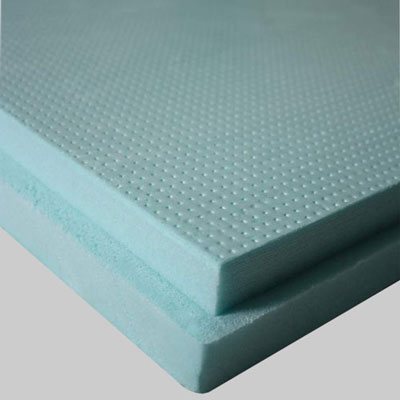

Expanded polystyrene board 10 cm thick and a brick wall more than 1 m have equal heat-conducting properties.
The air inside the bubbles is hermetically sealed, so the material perfectly retains heat.
The thermal conductivity coefficient varies in the range of 0.028 - 0.034 W / mK, which is much lower than the coefficient of brick or concrete.
Vapor permeability and moisture absorption
The vapor permeability index of expanded polystyrene foam is from 0.019 to 0.015 kg per meter-hour-Pascal, in contrast to an extruded product with a zero index.
The required thickness and shape is given using cutting the foam into slabs of the desired size... The steam flows through the granules into the cells.
note
Extruded polystyrene foam is not cut, because finished slabs come out of the conveyor of a certain thickness and are already smooth. As a result, steam cannot penetrate the material.
When a non-pressed product is immersed in water, up to 4% of the liquid is absorbed. Dense extruded polystyrene foam will remain almost dry and will absorb only 0.4%.
It is worth noting that the insulation will not be damaged in contact with liquids.
Strength
The material is durable, can withstand temperature from -40 to + 40 ° C up to 60 cycles (climatic years). The static bending strength of extruded material is superior to that of foamed material.
Sound absorption
A 3 cm layer of insulating material will reduce the noise penetration level by 25 decibels, which provides good sound insulation. Relevant for apartment residents.
But it will not completely relieve the noise, but only muffle it, in the presence of a thick layer of insulation. Airborne noise will not master.
Biological resistance
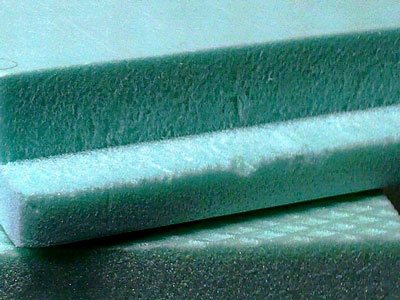

Polystyrene foam is not sensitive to the formation of biological activity and therefore will not become a breeding ground for mold and fungi.
This is a scientifically proven fact.
However, it can be damaged by rodents and insects. They make their way through the material in search of warmth and food.
We recommend: What is the best plaster - gypsum or cement? Which one to choose for leveling the walls
Destruction of expanded polystyrene
High temperature destruction
The high-temperature phase of destruction of expanded polystyrene has been well and thoroughly studied. It starts at a temperature of +160 ° C. As the temperature rises to +200 ° C, the phase of thermal oxidative destruction begins. Above +260 ° C, the processes of thermal destruction and depolymerization prevail. Due to the fact that the heat of polymerization of polystyrene and poly - "" α "" - methylstyrene is one of the lowest among all polymers, depolymerization to the initial monomer, styrene, predominates in the processes of their destruction [33].
Modified polystyrene foam with special additives differs in the degree of high-temperature destruction according to the certification class. Modified polystyrene foam, certified according to class G1, does not degrade by more than 65% when exposed to high temperatures. The classes of modified polystyrene foam are given in the table in the section on fire resistance.
Low temperature destruction
| The style of this section is unencyclopedic or violates the norms of the Russian language. The section should be corrected according to the stylistic rules of Wikipedia. |
Foamed polystyrene, like some other hydrocarbons, is capable of self-oxidation in air to form peroxides. The reaction is accompanied by depolymerization. The reaction rate is determined by the diffusion of oxygen molecules. Due to the significantly developed surface of expanded polystyrene, it oxidizes faster than polystyrene in a block [34]. For polystyrene in the form of dense products, the temperature factor is the regulating beginning of destruction. At lower temperatures, its destruction is theoretically possible in accordance with the laws of thermodynamics of polymerization processes, but due to the extremely low gas permeability of polystyrene, the partial pressure of the monomer can only change on the outer surface of the product.Accordingly, below Tpred = 310 ° C, the depolymerization of polystyrene occurs only from the surface of the product, and it can be neglected for practical purposes.
Doctor of Chemistry, Professor of the Department of Plastics Processing at the Russian Chemical Technology University named after V.I. Mendeleeva L.M. Kerber on the separation of styrene from modern expanded polystyrene:
“Under normal operating conditions, styrene will never oxidize. It oxidizes at much higher temperatures. The depolymerization of styrene can indeed proceed at temperatures above 320 degrees, but it is impossible to seriously talk about the release of styrene during the operation of expanded polystyrene blocks in the temperature range from minus 40 to plus 7 ° C. In the scientific literature there is evidence that the oxidation of styrene at temperatures up to +11 ° C practically does not occur. "
Experts also claim that a drop in the impact toughness of the material at 65 ° C was not observed over an interval of 5000 hours, and a drop in the impact strength at 20 ° C was not observed over 10 years.
The toxic nature of styrene and the ability of expanded polystyrene to release styrene is considered by European experts to be unproven. Experts, both in the construction and chemical industries, either deny the very possibility of oxidation of expanded polystyrene under normal conditions, or point to the absence of precedents, or refer to their lack of information on this issue.
In addition, the very danger of styrene is initially often exaggerated. According to large-scale scientific studies carried out in 2010 in connection with the passage of the mandatory procedure for re-registration of chemicals in the European Chemicals Agency in accordance with the REACH regulation, the following conclusions were made:
- mutagenicity - no basis for classification;
- carcinogenicity - no basis for classification;
- reproductive toxicity - no basis for classification.
What's more, keep in mind that styrene is naturally found in coffee, cinnamon, strawberries, and cheeses.
Thus, the main concerns associated with the particular toxicity of styrene, allegedly released when using expanded polystyrene, are not confirmed [33].
Styrofoam structure
The structure and tasks in which it is applied have been embodied in the form in which it is produced - the implementation of this solution was the form of the slab. Plates can be of different sizes and thicknesses, but the shape itself is easy to install, store and transport.
One of the main characteristics of polystyrene that affect its area of application is its density and thickness.
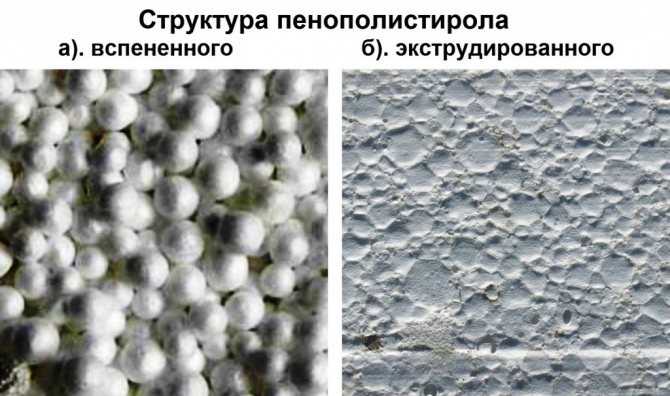

Density is of several types, within the following limits (unit of measurement kg / m3): up to 15, from 15 to 25, from 25 to 35, from 35 to 50. Consider three densities 15, 25 and 35.
15 is the lowest. Very rarely applied to facades that are adjacent to a building. Well suited for non-residential buildings.
25 is the best choice in terms of price and quality. She is the most used one.
35 - used for warming house facades, slopes on doors and windows, sheets of smaller thickness can be used without deterioration in quality. It is harder and therefore ideal for basements, home foundations, and high impact walls.
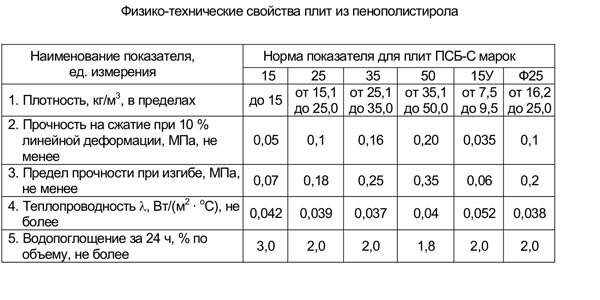

Thickness nstarts from 20 mm and goes up to 100 mm in 10 mm increments, after one hundred millimeters there is a thickness of 120 and 150 mm, respectively. The most demanded thickness on the market is 5 - 7 cm, which is suitable for many tasks in most cases. Sometimes it is necessary to level the wall, this result can be achieved by using a 15 cm slab, cutting it at the right angle or in places of depressions or protrusions.
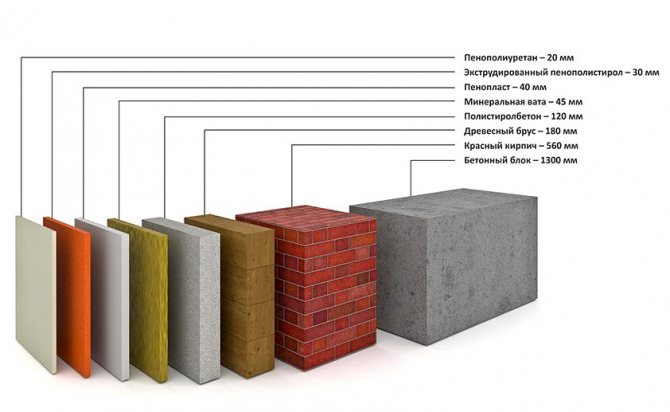

Fire hazard of expanded polystyrene
Fire hazard of untreated polystyrene foam
Unmodified polystyrene foam (flammability class G4) is a flammable material, the ignition of which can occur from the flame of matches, a blowtorch, from autogenous welding sparks.Expanded polystyrene does not ignite from a calcined iron wire, a burning cigarette and sparks generated at the point of steel [35]. Expanded polystyrene refers to synthetic materials that are characterized by increased flammability. It is able to store energy from an external heat source in the surface layers, spreading fire and initiating fire intensification [36].
The flash point of expanded polystyrene ranges from 210 ° C to 440 ° C depending on the additives used by the manufacturers [37] [38]. The ignition temperature of a specific modification of polystyrene foam is determined according to the certification class.
When conventional expanded polystyrene (G4 flammability class) ignites, a temperature of 1200 ° C develops in a short time [35]; when using special additives (fire retardants), the combustion temperature can be reduced according to the combustion class (G3 flammability class). Combustion of expanded polystyrene takes place with the formation of toxic smoke of varying degrees and intensity, depending on the impurities added to the expanded polystyrene to reduce smoke generation. Smoke emission of toxic substances is 36 times greater in volume than that of wood.
Combustion of ordinary expanded polystyrene (G4 flammability class) is accompanied by the formation of toxic products: hydrogen cyanide, hydrogen bromide, etc. [39] [40].
For these reasons, products made of untreated polystyrene foam (flammability class G4) do not have approval certificates for use in construction work.
Manufacturers use expanded polystyrene modified by special additives (fire retardants), thanks to which the material has different classes of ignition, combustibility and smoke generation.
Thus, with correct installation, in accordance with GOST 15588-2014 “Foam polystyrene heat-insulating plates. Technical conditions ", expanded polystyrene does not pose a threat to the fire safety of buildings. The "wet facade" technology (WDVS, EIFS, ETICS), which implies the use of expanded polystyrene as insulation in the building envelope, is widely used in construction.
Modified polystyrene foam for fire safety
To reduce the fire hazard of expanded polystyrene, when it is received, fire retardants are added to it. The resulting material is called self-extinguishing polystyrene foam (flammability class G3) and is indicated by a number of Russian manufacturers with an additional letter "C" at the end (for example, PSB-S) [41].
On 05/01/2009, a new federal law FZ-123 "Technical regulations on fire safety requirements" came into effect. The methodology for determining the flammability group of combustible building materials has changed. Namely, in article 13, paragraph 6, a requirement appeared that excludes the formation of melt drops in materials with a group G1-G2 [42]
Considering that the melting point of polystyrene is about 220 ° C, then all heaters based on this polymer (including extruded polystyrene foam) from 01.05.2009 will be classified with a flammability group not higher than G3.
Before the entry into force of Federal Law 123, the flammability group of brands with the addition of flame retardants was characterized as G1.
A decrease in the combustibility of expanded polystyrene in most cases is achieved by replacing the combustible gas for "inflating" the granules with carbon dioxide [43].
Expanded polystyrene foam
For the first time, scientists tried to change the consumer properties of synthetic polymers based on styrene by filling with gas in 1929. A year later, the novelty was introduced into mass production under the name expanded polystyrene foam. The composition was officially patented in 1952 in Germany.
In Russia, the modified material is certified as a granular, deformation-resistant, non-flammable agent intended for arranging heat and sound insulation of various structures (residential buildings, agricultural facilities, industrial buildings), operations to improve the performance of critical structures (floors, facades, ceilings, roofs) ...
Today, blocks from it are in demand by development and service organizations around the world. The growing relevance in the market of expanded polystyrene foam is due to the unique properties that a well-thought-out forming technology gives it.
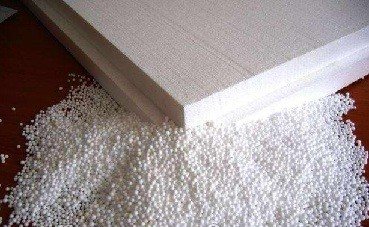

The material is made by means of high-temperature foaming of suspension polystyrene (crushed in the water phase by intensive stirring) combined with a fire retardant. The technique using the impact force of steam makes it possible to melt the components of the cell structure with each other.
The tight adhesion of the granules makes the resulting boards super-strong, inert to short, strong and long-term, consistently high loads. Capable of springing under active pressure, they do not crumble from force, like brittle insulation, and do not crack like solid insulation.
Blocks made of air-saturated polymerized styrene do not change their configuration and do not shrink. The predominance in the gas composition (the ratio of 98% of air liquids to 2% of polymers), the versatility of the shape of the microscopic forming sections, the modest size of the granules (2-8 mm) endow them with the ability to retain heat efficiently and neutralize noise.
Important! Based on the results of practical tests, expanded polystyrene foam was classified as fireproof (flammability group G1), environmentally friendly compositions. It is inexpensive to manufacture, it turns out to be modest in weight, strong, durable. Profiles from it are affordable, easy to transport, easy to load and unload, easy to install, not capricious in operation.
The material with a porous surface "breathes" well, guarantees normal circulation of air flows, and reduces the level of humidity. Dense insulation is characterized by low hygroscopicity: only the upper layers absorb moisture, the inner layers remain dry.
Notes (edit)
- Kabanov V.A. and others.
vol. 2 L - Polynose fibers // Encyclopedia of Polymers. - M .: Soviet Encyclopedia, 1974 .-- 1032 p. - 35,000 copies. - French Patent No. 668142 (Chem. Abs. 24, 1477, 1930).
- German Patent No. 644102 (Chem. Abs, 31, 5483, 1937)
- Berlin A. An. Basics of the production of gas-filled plastics and elastomers. - M .: Goskhimizdat, 1956.
- Chukhlanov V. Yu., Panov Yu. T., Sinyavin A. V., Ermolaeva E. V. Gas-filled plastics. Tutorial. - Vladimir: Vladimir State University Publishing House, 2007.
- Kerzhkovskaya EM Properties and application of PS-B foam. - L: LDNTP, 1960.
- Andrianov R.A.New grades of expanded polystyrene. Building materials industry in Moscow. - Issue No. 11. - M .: Glavmospromstroimaterialy, 1962.
- Federal Republic of Germany patent No. 92606 dated 04/07/1955.
- Discussion and Possible Action Regarding a Ban of the Use of Expanded Polystyrene (EPS) Food Containers (Study Issue) // December 18, 2012.
- POLICY TOOLS FOR REDUCING IMPACT OF SINGLE-USE, CARRYOUT PLASTIC BAGS AND EPS FOOD PACKAGING // Final Report June 2, 2008
- Nguyen L. An Assessment of Policies on Polystyrene Food Ware Bans.// San Jose State University 10.01 / 2012
- S8619 Prohibits food establishments from using expanded polystyrene foam disposable food service containers beginning 1/1/15.
- GOST 15588-2014 “Foam polystyrene heat-insulating plates. Technical conditions ". Entered into force on 01.07.2015
- GOST R 53786-2010 “Composite thermal insulation facade systems with external plaster layers. Terms and Definitions"
- GOST R 53785-2010 “Composite thermal insulation facade systems with external plaster layers. Classification"
- LETTER of the State Construction Committee of the Russian Federation N 9-18 / 294, GUGPS of the Ministry of Internal Affairs of the Russian Federation N 20 / 2.2 / 1756 dated 06/18/1999 "ON INSULATION OF THE EXTERNAL WALLS OF BUILDINGS"
- Letter from FGBU VNIIPO EMERCOM of Russia dated 07.08.2014 No. 3550-13-2-02
- FEDERAL LAW TECHNICAL REGULATIONS ON FIRE SAFETY REQUIREMENTS dated 22.07.2008 No. 123-FZ
- Bjorvika
- Styrofoam designer furniture - constructive and affordable
- Styrofoam robots
- Pavlov V.A. Expanded polystyrene. - M .: "Chemistry", 1973.
- Khrenov A.E. Migration of harmful impurities from polymeric materials during the construction of underground structures and laying of communications. - No. 7. - 2005.
- Egorova EI, Koptenarmusov VB Fundamentals of polystyrene plastics technology. - St. Petersburg: Himizdat, 2005.
- Table of density, thermal conductivity and vapor permeability of various materials
- Table of density, thermal conductivity and vapor permeability of various materials: Repair and furnishing of an apartment, building a house - my answers to questions
- Semenov SA Destruction and protection of polymeric materials during operation under the influence of microorganisms // Dissertation for the degree of Doctor of Technical Sciences, Russian Academy of Sciences Institute of Chemical Physics. N.N.Semenova. - M., 2001.
- Atiq N. Biodegradability of Synthetic Plastics Polystyrene and Styrofoam by Fungal Isolates // Department of Microbiology Quaid-i-Azam University, Islamabad, 2011.
- Naima Atiq T., Ahmed S., Ali M., Andleeb S., Ahmad B., Geoffery R. Isolation and identification of polystyrene biodegrading bacteria from soil.//African Journal of Microbiology Research Vol. 4 (14), pp. 1537-1541, 18 July, 2010.
- Richardson N. Beurteilung von mikrobiell befallenen Materialien aus der Trittschalldämmung // AGÖF Kongress Reader September 2010.
- Hed G. Service Life Estimations of Building Components. Munich: Hanser. Report TR28: 1999. Gävle, Sweden: Royal Institute of Technology, Center for Built Environment, Stockholm, 1999. - P. 46.
- Test report No. 225 dated 25.12.2001. NIISF RAASN. Testing laboratory for thermophysical and acoustic measurements)
- ↑ 12
Expanded polystyrene - Properties. 4108.ru. Retrieved April 10, 2016. - Emmanuel NM, Buchachenko AL Chemical physics of aging and stabilization of polymers. - M .: Nauka, 1982.
- ↑ 12
OCT 301-05-202-92E “Expandable polystyrene. Technical conditions. Industry standard " - Guyumdzhyan P.P., Kokanin S.V., Piskunov A.A.On fire hazard of polystyrene foam for construction purposes // Pozharovzryvoopasnost. - T. 20, No. 8. - 2011.
- Minutes No. 255 dated 28.08.2007 for the identification control of expanded polystyrene material PSB-S 25 FGU VNIIPO EMERCOM of Russia
- Kodolov V.I.Flammability and fire resistance of polymeric materials. M., Chemistry, 1976.
- Toxicity of combustion products of synthetic polymers. Survey information. Series: Polymerized plastics. - NIITEKHIM, 1978.
- Toxicity of volatile products from thermal exposure to plastics during processing. Series: Polymerized plastics. - NIITEKHIM, 1978.
- Evtumyan A.S., Molchadovsky O.I. Fire hazard of heat-insulating materials from expanded polystyrene. Fire safety. - 2006. - No. 6.
- Federal Law of 22.07.2008 N 123-FZ (as amended on 03.07.2016) "Technical regulations on fire safety requirements" (Russian) // Wikipedia. - 2017-03-12.
- Basic Fire Safety Requirements - Thermal Insulation Systems

